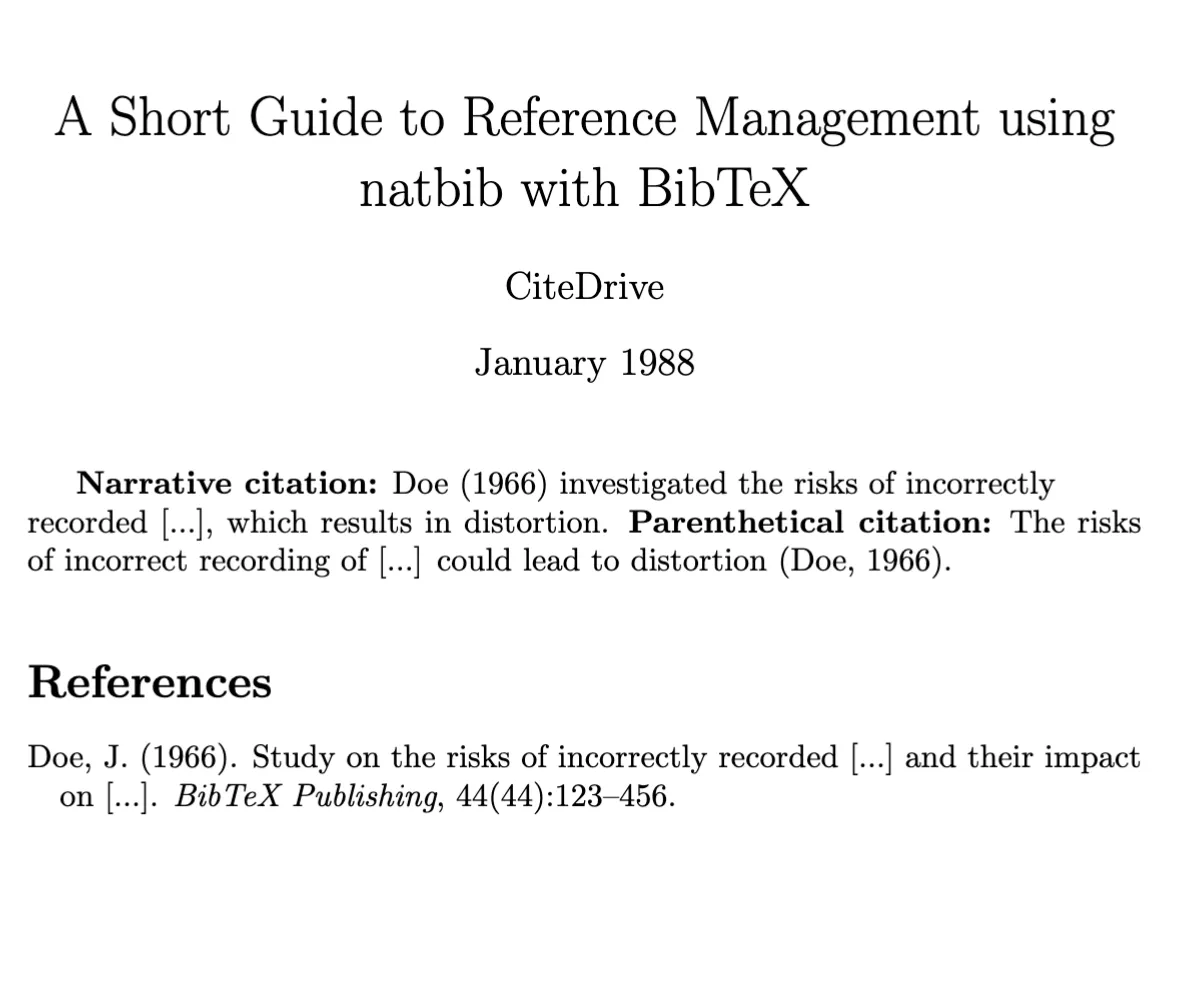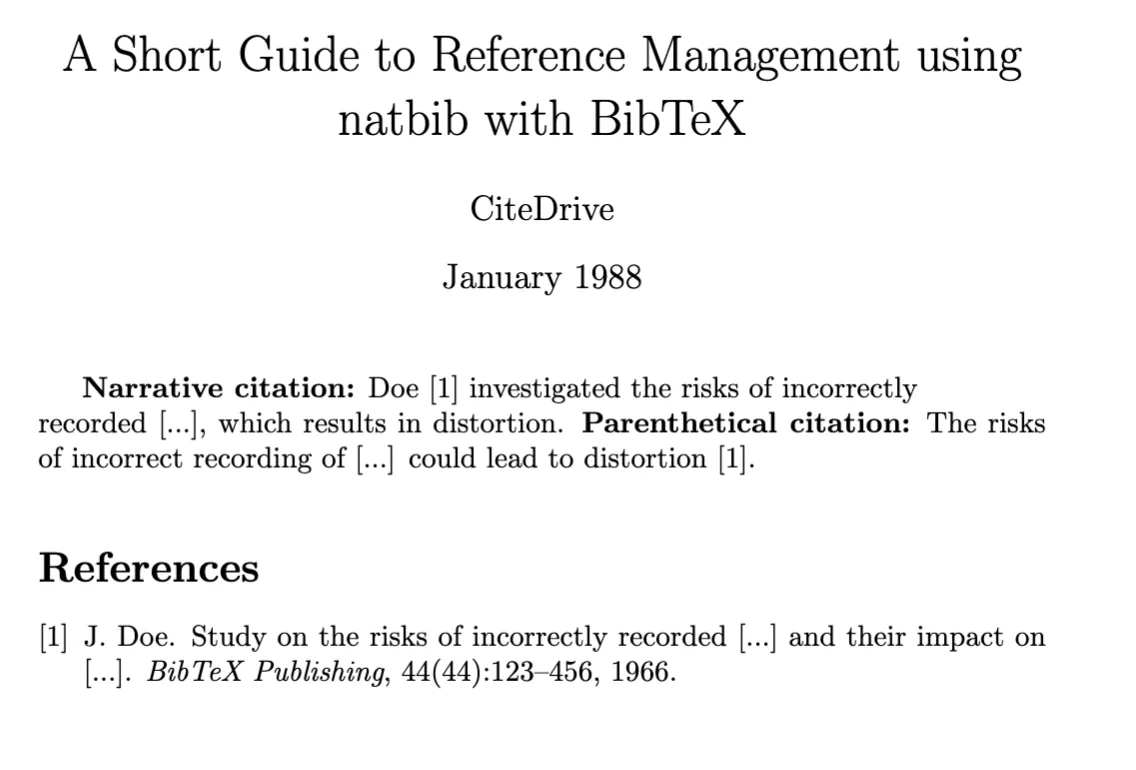Natbib 教程:使用 BibTeX 在 LaTeX 中掌握参考文献管理
使用 natbib 包,LaTeX 中的参考文献管理变得更加简洁高效。无论你是使用传统的 \cite{*} 命令,还是深入探讨高级引用方法,本指南提供了基础知识,帮助你快速上手。
natbib 简介及其优势
natbib 包扩展了 LaTeX 中标准的 \cite{*} 命令的功能。它在文中引用方面表现出色,提供了多种选项和自定义功能,尤其适用于作者-年份引用格式,并且与 BibTeX 集成时可以显示文本和圆括号引用。
接下来,让我们深入探讨如何利用 natbib 的强大功能来格式化和引用你的参考文献。
快速入门:使用 natbib 的括号引用和文本/叙述引用
设置 natbib 的结构与标准的 LaTeX 设置相似。首先,通过 \usepackage{natbib} 加载库。该库提供了多个配置选项,通过 \usepackage[options]{natbib} 进行设置,下面将详细介绍。Natbib 中的主要引用命令是 \citet{*} 用于文本/叙述引用,\citep{*} 用于括号引用。
\documentclass{article}\usepackage{natbib}\bibliographystyle{apalike}\title{使用 natbib 和 BibTeX 进行参考文献管理的综合指南}\author{CiteDrive}\date {1988年1月}
\begin{document}
\maketitle\textbf{叙述性引用:} \citet{Doe:1966} 研究了错误记录的风险,\\这会导致数据失真。\textbf{括号引用:} 错误记录的风险可能导致失真\citep{Doe:1966}。
\medskip
\bibliography{sample}
\end{document}通过使用 \bibliography{sample},你将 LaTeX 指向你的 .bib 文件,该文件包含如下参考文献条目:
@article{Doe:1966, title = {关于错误记录的风险及其影响的研究}, author = {John Doe}, year = 1966, journal = {BibTeX 出版社}, volume = 44, number = 44, pages = {123--456}}@article{smith2017, title = {一篇有趣的文章}, author = {John Smith}, year = {2017}, journal = {有趣文章期刊}} 使用 BibTeX 和 natbib 进行参考文献管理的输出示例
使用 BibTeX 和 natbib 进行参考文献管理的输出示例
对于偏好数字引用格式的用户,以下是如何调整 natbib:
\usepackage[square,numbers]{natbib}\bibliographystyle{abbrvnat} 使用 BibTeX 和 natbib 进行数字样式参考文献管理的输出示例
使用 BibTeX 和 natbib 进行数字样式参考文献管理的输出示例
深入探讨:了解 natbib 中的 cite{*} 命令
了解 natbib 提供的各种 cite{*} 命令,可以帮助你更高效地引用文献。下表总结了这些命令的输出效果:
| 命令(单一引用) | 输出(作者-年份) | 输出(数字) | 命令(多个引用) | 输出(作者-年份) | 输出(数字) |
|---|---|---|---|---|---|
\citet{Doe:1966} | Doe (1966) | Doe [1] | \citet{Doe:1966,smith2017} | Doe (1966); Smith (2017) | Doe [1], Smith [2] |
\citet[chap.~4]{Doe:1966} | Doe (1966, chap. 4) | Doe [1, chap. 4] | \citet[chap.~4]{Doe:1966,smith2017} | Doe (1966); Smith (2017, chap. 4) | Doe [1], Smith [2, chap. 4] |
\citep{Doe:1966} | (Doe, 1966) | [1] | \citep{Doe:1966,smith2017} | (Doe, 1966; Smith, 2017) | [1, 2] |
\citep[chap.~4]{Doe:1966} | (Doe, 1966, chap. 4) | [1, chap. 4] | \citep[chap.~4]{Doe:1966,smith2017} | (Doe, 1966; Smith, 2017, chap. 4) | 1, 2, chap. 4] |
\citep[see][]{Doe:1966} | (see Doe, 1966) | [see 1] | \citep[see][]{Doe:1966,smith2017} | (see Doe, 1966; Smith, 2017) | [see 1, 2] |
\citep[see][chap.~4]{Doe:1966} | (see Doe, 1966, chap. 4) | [see 1, chap. 4] | \citep[see][chap.~4]{Doe:1966,smith2017} | (see Doe, 1966; Smith, 2017, chap. 4) | [see 1, 2, chap. 4] |
\citet*{Doe:1966} | Doe (1966) | Doe [1] | \citet*{Doe:1966,smith2017} | Doe (1966); Smith (2017) | Doe [1], Smith [2] |
\citep*{Doe:1966} | (Doe, 1966) | [1] | \citep*{Doe:1966,smith2017} | (Doe, 1966; Smith, 2017) | [1, 2] |
其他 natbib 命令,如 \citealp 和 \citealt,通过去掉括号提供了更多的灵活性。你可以在 natbib 使用参考手册 中查找所有命令。
附录:掌握 natbib 的选项
在使用 natbib 时,自定义其行为可以让你的工作流程更加顺畅。下面是通过 \usepackage[options]{natbib} 可用的选项介绍:
| 选项 | 描述 |
|---|---|
| round | 显示圆括号 |
| square | 显示方括号 |
| curly | 显示花括号 |
| angle | 显示尖括号 |
| semicolon | 多个引用用分号分隔 |
| colon | 与分号相同 |
| comma | 多个引用用逗号分隔 |
| authoryear | 显示作者-年份引用 |
| numbers | 显示数字引用 |
| super | 为数字引用显示上标 |
| sort | 按参考文献顺序排序多个引用 |
| compress | 在合适的情况下压缩排序和多个数字引用 |
| sort&compress | 在合适的情况下压缩多个数字引用 |
| longnamesfirst | 第一次引用时显示完整的作者名 |
| sectionbib | 重新定义 \thebibliography 以输出 \section 而非 \chapter |
| nonamebreak | 在一行中显示所有作者名 |
进一步阅读与资源
- 在 Overleaf 的 BibTeX 和 natbib 参考文献管理 中深入了解参考文献管理。
- 了解不同的参考文献样式,访问 Natbib 参考文献样式。
- 查阅方便的备忘单,访问 natbib 使用参考手册。
总结
使用 natbib 与 BibTeX 简化了 LaTeX 中的参考文献管理。本指南提供了从基础设置到复杂引用样式的全面教程。欲了解
更多信息,请查看我们的 完整参考资料。